Teaching the Whole Concept: Learning about where our food comes from
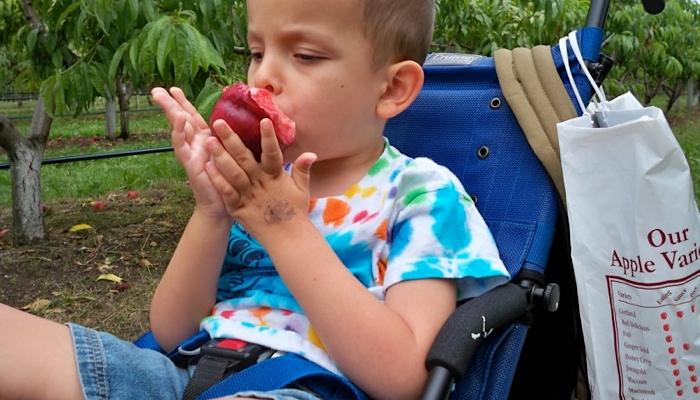
Learning whole concepts can be difficult and take some time for children with visual impairments.
Rather than trying to teach everything at once, give your child time to explore his world, piece together information, and gather as much real experiences as possible over time.
Think about learning as the construction of a strong chain. Each link, by itself, is a minute learning experience. But as your child progresses and understands more, he will eventually be able to construct an entire chain of knowledge.
Creating a Knowledge Chain
Let’s look at food, for example. Your child’s first experience with food may be that it magically appears ready for consumption on the table in front of him. He learns about textures and flavors, dishes and silverware.
This is actually a very good beginning, and it’s important to give your child this time to explore the plate and table and learn about the social constructs involved in eating together.
But how can you expand on this knowledge?
- What’s in the Kitchen? You may next think about bringing your child into the kitchen and showing him how food is prepared and stored. Where do those bowls come from? Where do we keep the milk and the cereal? Why is one kept cold and the other not? How do we put them all together to create a bowl of cereal?
These are all important links in the chain of understanding food. The kitchen is a wonderful place to encourage exploration and learning. You may want to read this article on Baking a Cake with Your Child for some ideas.
- Let’s Buy Some Food! Next, you could take your child to the grocery store or farmer’s market to get a better idea of where your food comes from. The refrigerator doesn’t just produce its own food! We need to go get it!
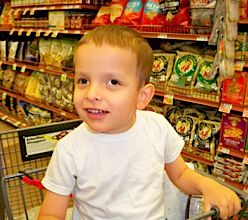 Shopping for food can be a real chore and it’s often easier to leave the kids at home, but if you can manage it, try bringing them along with you. Ivan loves to touch all the produce at the grocery store, even things we don’t buy. If I never buy a full pineapple (and I don’t—I usually buy canned pineapples) how will he learn that pineapples are spiky? Well, there are pineapples just waiting to be touched at the grocery store!
Shopping for food can be a real chore and it’s often easier to leave the kids at home, but if you can manage it, try bringing them along with you. Ivan loves to touch all the produce at the grocery store, even things we don’t buy. If I never buy a full pineapple (and I don’t—I usually buy canned pineapples) how will he learn that pineapples are spiky? Well, there are pineapples just waiting to be touched at the grocery store!Walking through the grocery store deli or bakery, Ivan learns about smells and I talk to him about what’s baking. In the center aisles Ivan touches cans and boxes and enjoys shaking them to hear the difference in sound—have you ever noticed that a box of pasta sounds very different than a box of rice?
At farmer’s markets kids can learn a bit more about farms and where their food is grown. They can talk to the farmers and you can discuss that certain fruits and vegetables are in season while others aren’t. There are also usually a lot of people walking their dogs at farmer’s markets and Ivan loves to pet dogs!
- Time to Visit the Farm! But I think the ultimate learning experience comes from visiting a real farm! Peaches are yummy to eat and your child may know now that you need to go to the store to get the peach before you can eat it, but where did that peach come from originally?
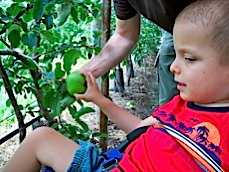 Talking about fruit and trees is a good start, but it’s a really hard concept to understand without touching the trees and actually feeling how the fruit and leaves are attached. Taking your child out to a pick-your-own-fruit orchard is a wonderful way to show them how trees grow and where fruit comes from. We love Lookout Farm in Natick Massachusetts.
Talking about fruit and trees is a good start, but it’s a really hard concept to understand without touching the trees and actually feeling how the fruit and leaves are attached. Taking your child out to a pick-your-own-fruit orchard is a wonderful way to show them how trees grow and where fruit comes from. We love Lookout Farm in Natick Massachusetts.Commercial fruit orchards usually trim their trees to grow low to the ground so even children in wheelchairs will be able to reach out and touch the lower branches, feel the leaves, and pick the fruit. Also, when fruits are in season farms will often organize celebrations that might involve music, cakes and pies, contests, hay rides, and more! And don’t forget how much fun it is to eat a ripe peach or plum right off the tree!
- Bringing Your Food Home. After visiting the farm and experiencing how food is grown, you’ll now have a huge bag full of produce. Take those fruits and veggies home, get your kid back in the kitchen, and have fun preparing and eating the food you make!
Here’s a cute video of Ivan eating a locally-grown peach from Lookout Farm:
You’ve just brought the entire concept full circle, from table to kitchen to store to farm and back to kitchen and table. And as long as your child was able to touch, feel, participate, and of course EAT, then you’ll know they learned something very valuable and memorable.
Taking the time to fill in the gaps in your child’s chain of knowledge is the best way to teach them whole concepts. Let them learn as they are engaged in an activity rather than trying to explain everything all at once. Experience is the best teacher!
And one more thing: If you like to enhance learning with music (like we do), then check out our favorite Songs About Food. Have fun!
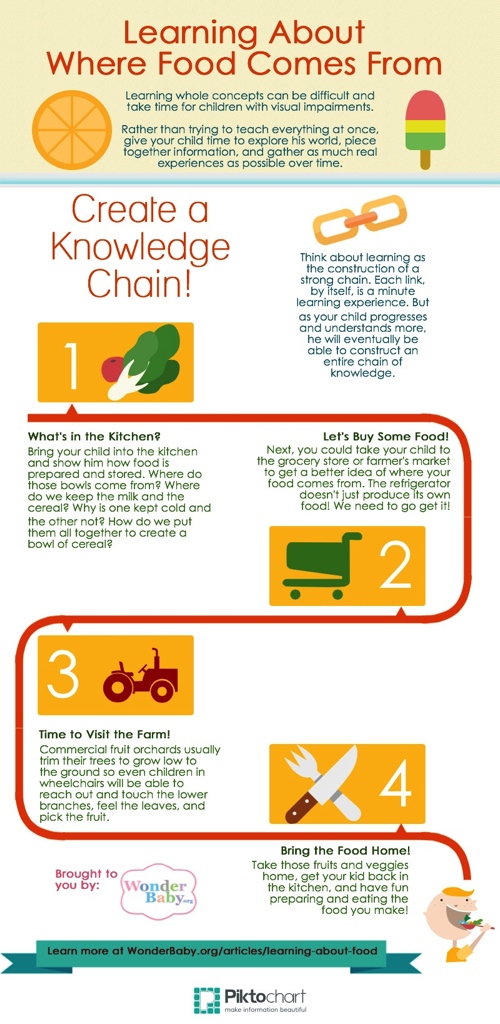
Related Posts
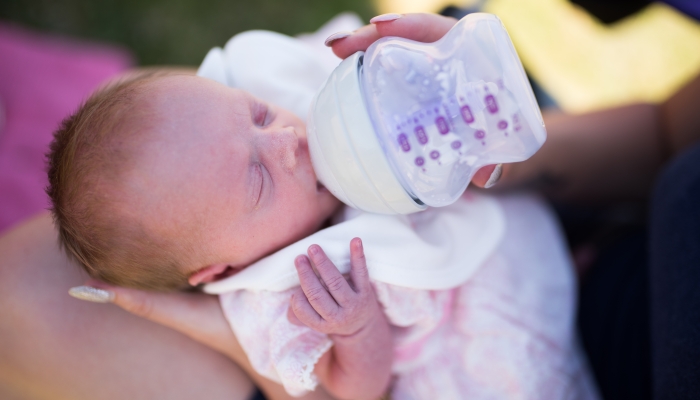
Feeding and Eating, Special Needs
Feeding Therapy Approaches for Infants with Special Needs
Many children with special needs have feeding difficulties. Working with a speech therapist, being patient, and experimenting with textures can help.

Feeding and Eating
Unexpected Foods That Cause Allergen Cross-Reactivity
A variety of unexpected foods and environmental substances can trigger an allergic reaction through cross-reactivity to food proteins.

Feeding and Eating
Easing Anxiety for Families Facing Food Allergies
Ongoing physical preparations and speaking openly about anxiety can ease the transition from diagnosis to living well with a food allergy.